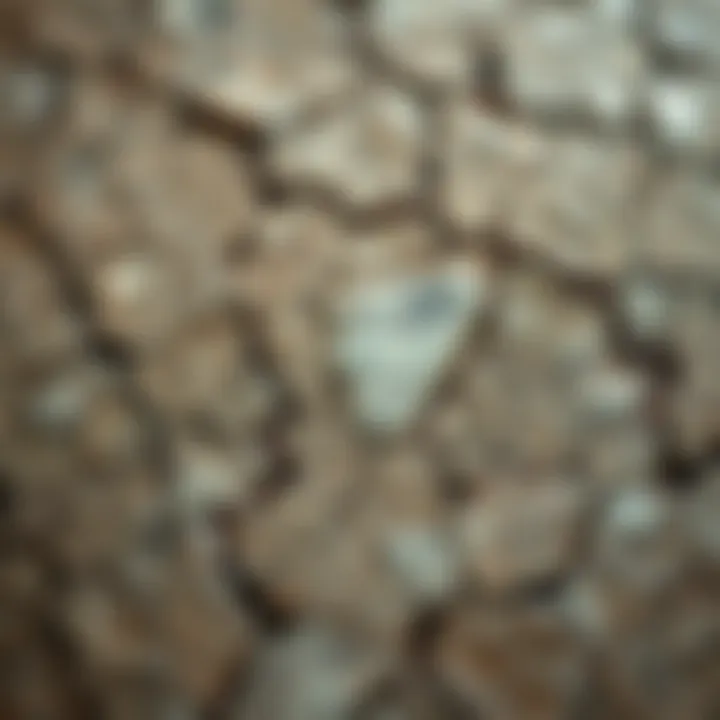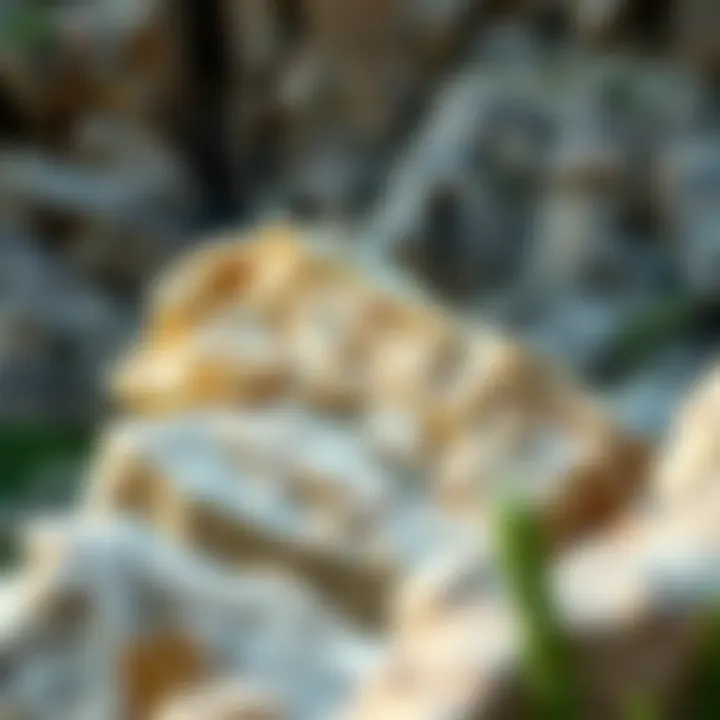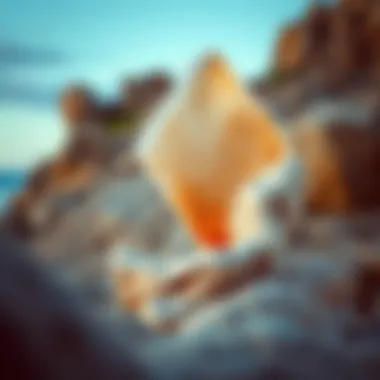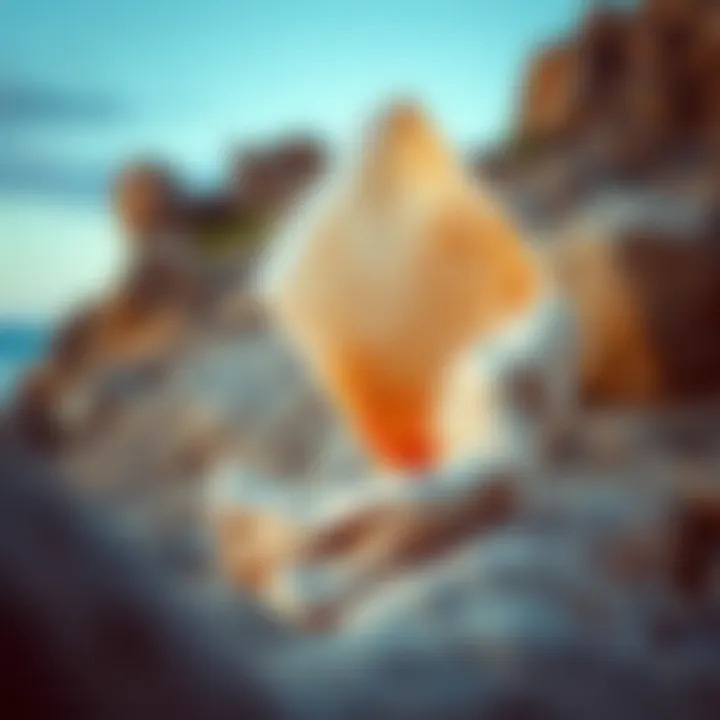In-Depth Look at Quartzite Rock: Formation and Uses


Intro
Quartzite is more than just a pretty face in the world of rocks. It's a metamorphic rock formed from sandstone subjected to intense heat and pressure over eons. Its transformation results in a durable, hard stone often sought after for its varied uses. What makes quartzite stand apart is not only its physical ruggedness but also its aesthetic appeal, making it a favored material in both construction and artistic endeavors.
As we delve deeper into this comprehensive exploration, we aim to peel back the layers to reveal not just the geology behind quartzite but also its significant applications and cultural relevance. Whether you're a seasoned rock hound or a curious beginner, this guide is designed to equip you with substantial knowledge that will enhance your appreciation of this remarkable natural stone.
Quartzite isn’t just another rock; it plays an integral role in various fields, ranging from architecture to art. Understanding quartzite's characteristics will help you appreciate its uses, and grasp the geological processes involved in its formation will provide a broader awareness of our planet’s dynamic nature. In the following sections, we will investigate the featured collectible of the month, delve into identification techniques, and explore the uses of quartzite in different spheres.”
Featured Collectible of the Month
Overview
In the spotlight this month is a stunning example of quartzite sourced from the rugged terrains of Brazil. Revered for its unique patterns and breathtaking colors, such as vibrant oranges and deep pinks, this quartzite specimen has captivated collectors and decorators alike. Its appeal lies not only in its aesthetics but also in its innate strength, making it suitable for various applications, from countertops to sculptures.
Admiring this piece is sure to stir up envy among fellow collectors due to its luminous quality under natural light. The intricate banding patterns often resemble ripples or waves, hinting at the tumultuous journey this rock has undergone to reach its current state.
Historical Significance
Historically, quartzite has played a pivotal role as a cultural and functional material. Indigenous tribes across North America utilized quartzite for tool-making around 12,000 years ago, shaped it into blades and projectile points, demonstrating the stone's workability despite its hardness. Likewise, in ancient architecture, quartzite has been employed to construct robust structures that have stood the test of time, from temples to fortifications. Its resilience and beauty have allowed it to transcend ages and cultures, finding relevance even in modern artistry.
"Quartzite is not just a stone, but a timeline of our planet's history, etched in its very fabric."
Identification Techniques
Visual Characteristics
Identifying quartzite can be quite the task if you're not well-acquainted with its unique qualities. Here are some key visual characteristics to look for:
- Color: Ranges from white to gray, often with vibrant hues like red, pink, or purple.
- Texture: Generally very granular with a glassy appearance, but it can also appear a bit dull depending on its polish.
- Patterns: Notable patterns can include wavy lines and swirls due to its sedimentary roots, especially if mixed with impurities.
Take care though; while quartzite may share some similarities with granite and sandstone, its distinct dense and tough quality sets it apart.
Resources for Identification
To deepen your understanding of quartzite and refine your identification skills, consider utilizing these resources:
- Wikipedia on Quartzite
- Quartzite Identification Guide on Britannica
- Communities on Reddit’s Rock Collecting
- Outreach from academic institutions, such as geology departments in various universities, offering insights on rock identification techniques.
In summary, the exploration of quartzite’s remarkable properties and significance reflects not just its geological formation but also highlights its multifaceted role across cultures and industries.
Intro to Quartzite
Quartzite plays a fundamental role in understanding the intricacies of metamorphic rocks and the geological processes behind their origin. In this article, we delve into the many dimensions of quartzite, a stone that boasts both durability and beauty. It's not just another rock; it encapsulates a rich history of transformation and usage that resonates with enthusiasts and professionals alike.
The significance of quartzite extends beyond mere aesthetics. For construction, its toughness makes it an ideal choice for flooring and countertops. In artistic expressions, the varied colors and textures of quartzite inspire both artists and designers. Understanding quartzite means recognizing its potential contributions across different fields, from geology and ecology to art and industry.
This section sets the stage for a detailed exploration of quartzite's definition, historical context, formation processes, and its significance in various spheres. By examining quartzite, we gain insights not only into a specific material but also into the broader narrative of Earth's geological history and cultural relevance.
Definition and Overview
Quartzite is primarily a metamorphic rock that forms from the heating and compression of sandstone. This process usually takes place deep within the Earth's crust, involving intense heat and pressure that re-crystallizes the mineral grains of the sandstone into quartzite. Visually, quartzite often appears as a solution of intricate patterns and hues, owing to its high silica content and the mingling of various minerals during its formation.
Characteristics that distinguish quartzite include its hardness, which can be likened to that of steel, and its resistance to weathering. It’s a fascinating material for rock collectors due to its diversity in colors—ranging from white and grey to vibrant pink and red, depending on its mineral impurities. In essence, quartzite is not just a rock; it’s a testament to the forces of nature that shape our planet.
Historical Perspective
Geological Timeline
The journey of quartzite begins in the geological timeline marked by epochs and eons, where sedimentary rocks underwent significant transformations. Sandstone, the parent rock of quartzite, is often formed in ancient riverbeds or shallow marine environments. Over millions of years, tectonic activity, pressure, and heat altered this sandstone, leading to the creation of quartzite.
A key characteristic of this timeline is how it illustrates the dynamic processes at play beneath the Earth's surface. The transformation from sandstone to quartzite is emblematic of the natural world’s resilience; it highlights how rocks can recycle and evolve, contributing to the geological tapestry we observe today. One benefit of exploring this timeline is the deeper appreciation it fosters for the complexities of rock formation, crucial for collectors aiming to understand and value their specimens.
Key Discoveries
Several important discoveries have shed light on quartzite's geological significance. Key sites around the world, such as the Appalachian Mountains and the Swiss Alps, have provided insight into the conditions that fostered quartzite formation. These areas boast some of the most renowned quartzite formations, compelling geologists and hobbyists alike to study their geological history.
The unique feature of these discoveries lies not only in their scientific value but also in their cultural implications. Many ancient civilizations utilized quartzite in their structures, bestowing upon it a practical significance that transcends its mere geological features. In this article, the discussions about these key discoveries underscore the importance of quartzite, providing a clearer picture of its utility and significance throughout human history and the natural world.
Formation of Quartzite
The formation of quartzite is a fascinating and intricate process that serves as the backbone for understanding this unique metamorphic rock. As it arises from another rock type, sandstone, studying its formation not only elucidates the geological transformations but also reveals hidden intricacies that define its unique traits. This section aims to explore the parent rock—sandstone—as well as the metamorphic processes of heat and pressure that together shape quartzite. Understanding these elements is vital for rock and fossil collectors, who seek to appreciate the deeper geological dynamics at play.
Parent Rock: Sandstone
Formation Process
Sandstone is the starting point of quartzite. This sedimentary rock primarily consists of sand-sized grains, usually quartz, that are cemented together by mineral substances. During the formation process, layers of sand accumulate in environments such as river beds, deserts, or ocean floors over millions of years. The incorporation of minerals like feldspar and clay can lead to varied compositions among different sandstones.
A key characteristic of this formation process is its ability to produce diverse textures and colors, contributing significantly to the aesthetic appeal of the resulting quartzite. The time taken for sedimentation allows for the grains to settle in an array of patterns, creating a visual tapestry woven by nature itself.
While sandstone is widely recognized as a readily available material, not all types are equally competent for metamorphosis into quartzite. For collectors, this aspect is crucial since identifying the right sandstone from which quality quartzite may evolve is foundational work. The challenge lies in discerning the types that are rich in quartz and less influenced by other minerals, which may alter the final product's properties. On the plus side, this formation process includes a geological story, making the collector's endeavor feel more impactful and enriched.
Types of Sandstone
There are several distinct types of sandstone, each having its characteristics that influence the formation of quartzite. For instance, arenite comprises a high percentage of quartz grains. In contrast, arkose contains significant feldspar, which can lead to a softer and less durable quartzite upon metamorphosis.
Identifying different sandstones enriches the collector's toolkit. Each variety presents a unique narrative of environment and time, and their similarities and differences are notable in the quartzites they eventually become. For example, while arenite might yield a highly resilient quartzite, arkose could result in a more friable variant. Understanding these types isn't just academic; it’s a practical element of creating a well-rounded collection.
Metamorphic Processes
Heat and Pressure Effects
The journey from sandstone to quartzite begins in earnest during the metamorphic phase, primarily driven by heat and pressure. When buried under layers of earth or subjected to tectonic shifts, sandstone undergoes changes that are crucial for its transformation into quartzite. Heat fosters the re-crystallization of the quartz grains, bringing about a tighter bond between them. Pressure compresses the rock, making it denser and more resilient.
This transformation is significant; it introduces a strength that sandstone lacks. The resultant quartzite can endure harsher environmental conditions, making it an invaluable resource across various industries. From construction to decorative uses, the durability imparted by heat and pressure solidifies quartzite's status as a go-to stone.
However, the extent of heat and pressure affects the final characteristics. Excessive heat can lead to excessive melting or alteration of existing minerals, which might not always result in desirable qualities. Remaining aware of these subtleties empowers both collectors and professionals to make informed choices.
Chemical Changes
Coupled with heat and pressure, chemical changes also play a decisive role in the metamorphic processes that engender quartzite. During metamorphism, the quartz grains can react with the surrounding materials, allowing for a different kind of mineral composition to form. This chemical reaction may introduce new minerals or modify existing ones, contributing to the rock’s overall identity.
A defining trait of these chemical changes is their ability to enhance or detract from quartzite's durability and aesthetic appeal. For instance, impurities that latch onto the quartz can lend colors and veining patterns that are not just visually stunning but also valuable in artistic and practical applications. Collectors often seek these unique features, finding beauty in the imperfections and variations that result from these chemical interactions.
In summary, the processes of both heat and pressure, alongside chemical transformations, create a narrative that is both complex and rich. Understanding how quartzite is formed provides insight not only into the rock itself but also into the forces of nature that shape the Earth. This knowledge can significantly enhance the appreciation for quartzite among rock enthusiasts and collectors alike.


Characteristics of Quartzite
The essence of quartzite can be distilled into its characteristic features, which make it a sought-after material in various fields. Understanding these attributes is essential not only for enthusiasts and collectors but also for those involved in construction and design. The physical and chemical properties of quartzite inform us about its potential uses, how it interacts with the environment, and its place in geological studies.
Physical Properties
Color Variations
One striking feature of quartzite is its color variations. Ranging from pristine whites to deep reds, yellows, and blues, these colors are the result of different mineral impurities during its formation. Typically, the patterns and hues can be further impacted by the sedimentary layers that were present in the parent sandstone. In the world of rock collecting, this makes color one significant aspect; collectors often seek out unique colors to enhance their collections.
- Key Characteristics: A highly sought-after benefit is that the rich colors in quartzite can add character to landscapes and constructions. For instance, a light-colored quartzite can brighten up a space, while darker variants might add a dramatic flair.
- Unique Features: From a geological standpoint, the interplay of colors can indicate the specific conditions of formation, making it a conversation starter among collectors.
- Considerations: However, one disadvantage is that certain colors may be more prone to fading under UV light, necessitating protective measures if used externally.
Texture and Grain
When it comes to texture and grain, quartzite's durability is perhaps its defining feature. The density and homogeneity of the rock lend it a unique tactile quality that collectors often appreciate.
- Key Characteristics: The texture of quartzite can vary from fine to coarse granules, which can be attributed to the size of the original sandstone particles. This variety makes it suitable for various design needs, particularly in both interior and exterior applications.
- Unique Features: A distinguishing factor is the glassy sheen sometimes found on polished surfaces, giving quartzite that appealing glow.
- Considerations: On the flip side, its hard nature can make it difficult to work with for detailed carvings, limiting its use in more intricate artistic endeavors.
Chemical Composition
Silica Content
One of the most critical aspects of quartzite is its high silica content, often exceeding 90%. This feature confers remarkable durability and resistance, qualities that are crucial for construction materials.
- Key Characteristics: The elevated silica content means quartzite can endure weathering and abrasion without losing its integrity. As a building material, it can stand the test of time, retaining its aesthetic appeal even in harsh environments.
- Unique Features: The chemical bonding in quartzite results in a strong, resilient rock, making it an ideal choice for countertops and tiles.
- Considerations: On the downside, the high silica content also means quartzite can be more difficult to cut and shape than softer stones.
Impurities
Impurities within quartzite can greatly influence its properties and appearance. These elements often come from the original sandstone and can include iron oxides and clay minerals.
- Key Characteristics: Certain impurities can produce color variations, which enhance quartzite's visual appeal. They can also add interesting streaks and patterns, making each specimen unique.
- Unique Features: As these impurities react with various elements, they can lend interesting uses beyond aesthetics, such as contributing to erosion resistance.
- Considerations: However, some impurities may affect the durability of quartzite, particularly when the rock is subject to prolonged exposure to moisture.
Understanding these characteristics establishes quartzite not merely as a stone, but as a narrative woven through the earth's geological history. Its multifaceted qualities not only highlight its beauty but also its resilience and enduring significance.
The diversity within quartzite, from physical attributes like color and texture to its chemical makeup, provides vital insights for anyone working with or collecting this fascinating rock. Each aspect plays a crucial role in defining not just the rock itself, but also the broader implications of its applications in our world.
For further in-depth exploration, resources like Britannica or Wikipedia could be beneficial. And if collectors want to share their experiences or seek advice, platforms such as reddit can be a community resource.
Types of Quartzite
When understanding quartzite, it's essential to dive into its various types. Each classification of quartzite holds significance in both geology and its practical applications. Analyzing these types helps rock and fossil collectors appreciate the diversity and characteristics that can be found in quartzite formations.
Based on Formation
Classic Quartzite
Classic quartzite is a standout in the geological world. This type forms typically when sandstone undergoes metamorphism due to heat and pressure, resulting in a rock that showcases unique durability. A key characteristic of classic quartzite is its grainy texture, often visible in cross-sections, making it appealing for both collectors and builders alike.
One of the advantages of classic quartzite is its robust nature, making it an excellent choice for construction purposes. Its ability to withstand harsh weather conditions while maintaining aesthetic appeal adds to its popularity. However, the challenge lies in its procurement, as it tends to be less abundant compared to other rock types.
Feldspathic Quartzite
Feldspathic quartzite brings a rich variety into the quartzite realm. This type generally consists of a higher concentration of feldspar, which alters its overall appearance and characteristics. A notable feature of feldspathic quartzite is its unique coloration and flecks, giving it an added flair that can catch the eye of any collector.
The presence of feldspar not only differentiates it visually but also influences its weathering processes, which can be both a boon and a bane. While this can offer a diverse range of appearances, it can also lead to somewhat less durability compared to classic quartzite. This aspect poses a consideration for its use in high-wear environments.
Color-Specific Quartzites
White Quartzite
White quartzite stands out in the industry for its striking purity and elegance. Formed from quartz-rich sandstone, it is characterized by its light coloration and transclucency. White quartzite tends to be sought after for high-end construction and design projects, reflecting luxury and sophistication.
One of the most significant advantages of white quartzite is its versatility; it can be used in countertops, flooring, and decorative accents. However, one must consider that white quartzite is prone to staining if not sealed properly, making care an essential aspect of maintaining its pristine look.
Colored Variants
Colored variants of quartzite add a splash of personality into the mix. These types can range in hue from deep reds to vibrant greens, encompassing naturally occurring impurities that give each piece its unique flair. Colored quartzite is popular among decorators and landscape designers, bringing life to any project.
The uniqueness of colored variants often makes them a favorable choice; however, collectors should be cautious as their unique coloration can sometimes indicate variable quality. It's wise to ensure proper sourcing to avoid inconsistencies in durability and appearance.
Understanding the varied types of quartzite broadens not only one's geological knowledge but also enhances the appreciation for its multifaceted uses and characteristics.
Uses of Quartzite
Quartzite holds a significant position in various industries and has a myriad of applications that showcase its versatility. Understanding its uses is crucial as it sheds light on why quartzite is not just another rock, but a valuable resource in both construction and artistic endeavors, among other fields.
In Construction
Building Materials
Quartzite is often used as a building material due to its hardness and durability. Unlike other stones that may chip or wear down over time, quartzite is tough as nails, making it an ideal choice for surfaces that endure a lot of wear. This characteristic is particularly appealing in areas like flooring and countertops, where aesthetics meet strength. The unique feature of quartzite is its rich variety of colors, ranging from neutral tones to deep reds and greens, which can enhance the visual appeal of any space. On the downside, the weight of quartzite may complicate handling and installation, and its cost can be higher than alternatives like granite or laminate. But for those willing to invest, the longevity and beauty of quartzite often justify the expense.
Landscaping
When it comes to landscaping, quartzite shines brightly. Its natural beauty and resilience against weathering make it a popular choice for outdoor features like paths and garden walls. The distinct color variations of quartzite can complement different landscape designs, adding an elegant touch to any garden. The key characteristic here is not just its looks but also its ability to resist erosion and withstand harsh conditions. However, potential drawbacks include the higher initial costs and the need for proper installation to prevent settling or shifting. Still, landscape artists and homeowners alike appreciate that quartzite can transform outdoor areas into stunning retreats, worth every penny.
In Industry
Manufacturing Glass
Quartzite is a critical component in the manufacture of glass. Its primary material, silica, is a major ingredient in glass-making processes. The high purity levels of quartzite can directly affect the quality of the glass produced. This makes it a desirable choice for factories aiming to produce premium products. Though it may seem like a straightforward application, the nuances involved in sourcing high-quality quartzite for glass manufacturing cannot be overlooked. If impurities find their way into the mix, they can compromise the final product's clarity. Thus, while quartzite’s role in glass production is often underestimated, it remains indispensable in delivering quality materials to a demanding market.
Electrical Applications
In the realm of electrical applications, quartzite has its unique advantages. It is often used in the creation of certain types of electrical insulators due to its insulating properties. The ability of quartzite to withstand high voltages is critical for keeping systems functional and safe. This characteristic is beneficial for electrical manufacturers who need reliable materials for their products. However, sourcing quartzite that meets stringent electrical standards can be a challenge. There's also the aspect of cost-effectiveness; manufacturers must balance quality with expense. Yet, when it comes to making durable electrical components, quartzite frequently proves itself as a rock-solid choice.
Art and Design
Sculpture Materials
Artists frequently turn to quartzite for sculpture materials due to its compelling aesthetics and workability. The stone’s varied grains and colors can result in striking artworks, from abstract pieces to realistic figures. A noteworthy aspect of quartzite is that it holds fine details well, allowing sculptors to achieve intricate designs. Despite the challenges associated with working with hard materials like quartzite—including the need for specialized tools—many artists find the results worth the effort. Its durability means that sculptures can withstand outdoor conditions, preserving the artist's vision for years to come.
Interior Design Elements
In interior design, quartzite is prized for its uniqueness and elegance. Whether it’s used in kitchens, bathrooms, or living spaces, quartzite countertops and backsplashes are becoming increasingly popular for their sweeping patterns and vibrant hues. The key characteristic of quartzite in interior design is its ability to blend functionality with beauty, serving as both a practical surface and a stunning visual centerpiece. There is, however, the potential for scratches and stains if not properly sealed. Therefore, homeowners must consider maintenance alongside aesthetics. Despite these considerations, quartzite remains a favored material for those looking to make a statement in their homes.
Quartzite in the Natural Environment


Quartzite plays a crucial role in natural ecosystems by affecting both the landscape and the organisms that inhabit it. This metamorphic rock, born from the transformation of sandstone under heat and pressure, offers not just aesthetic appeal but also practical benefits in various environments. Understanding quartzite's interaction with the natural world can enhance our appreciation of its geological significance.
Geographical Distribution
Major Deposits Worldwide
When it comes to quartzite, certain global locations are renowned for their significant deposits. Notably, the Mason Quarry in Virginia and the Sierra Nevada range in California are two prime examples where quartzite is abundant. These areas not only yield high-quality specimens but also provide insights into the geological history of our planet.
The major characteristic of these deposits is their hardness and resistance to weathering. This makes quartzite a preferred choice for construction and landscaping projects. In fact, many historical buildings and monuments are fashioned from this rock, attaching to our cultural heritage. Its vibrant colors and diverse textures add visual warmth to the surroundings.
However, extracting quartzite from these locations can create environmental challenges. Quarrying activities often disrupt local ecosystems, leading to habitat loss for various species. This brings about the necessity for responsible mining practices that prioritize the balance between extraction and environmental care.
Local Geologies
Just as important as major deposits, local geologies where quartzite is found contribute distinct features worth mentioning. For instance, in the Appalachian Mountains, quartzite is often interspersed with other sedimentary rocks, creating unique geological formations. This region is characterized by its rugged landscape and diverse microclimates that can influence the surrounding flora and fauna.
Local geologies provide smaller, yet rich deposits of quartzite, often found in alluvial forms along riverbeds. These variations can offer rock collectors a chance to gather samples showcasing the diverse appearances of quartzite. Additionally, they contribute to the formation of soil in these areas, indirectly supporting agricultural activities. Still, certain challenges remain, such as the maintenance of soil quality amidst extraction activities.
Impact on Ecosystems
Soil Influence
Quartzite has a unique influence on soil composition. The loose grains can improve drainage, making it a beneficial component in regions prone to flooding. This is particularly important in agricultural settings where soil health is of utmost importance. In areas where quartzite is prevalent, crops tend to flourish better due to improved moisture retention and aeration.
Yet, there's a flip side. If too much quartzite is introduced into the soil, it can lead to nutrient deficiencies. Farmers and landowners need to strike a balance, understanding how the presence of quartzite can affect overall soil health.
Biodiversity Factors
Quartzite regions often boast unique biodiversity owing to the varieties of microhabitats formed around these rocks. Species adapted to the hard terrain thrive in these areas, from specialized plants to various animal life. For example, the Rocky Mountain region showcases unique flora that specifically thrives in quartzite environments. Lists of endemic species can tell the stories of survival and adaptation that have occurred over millennia.
However, the biodiversity surrounding quartzite deposits can be fragile. Human encroachment and mining can lead to habitat destruction and fragmentation, putting species at risk. Thus, conservation efforts are essential to ensure these natural habitats remain intact and vibrant.
"Understanding the environment in which quartzite exists not only illuminates its geological importance but also emphasizes our responsibility to protect these natural spaces for future generations."
Collecting Quartzite
Collecting quartzite can be a fascinating endeavor, blending the thrill of discovery with the satisfaction of acquiring a unique specimen. For both seasoned rockhounds and budding collectors alike, understanding how to navigate this process is essential. Quartzite, due to its striking appearance and robustness, not only serves as a great decorative piece, but it also imposes questions of environmental responsibility and ethical sourcing. Thus, let's delve into the guidelines and care practices vital for collectors of this remarkable stone.
Guidelines for Collectors
Where to Find Quartzite
To track down quartzite, one must be aware of likely locations across various terrains. Common places to find quartzite include:
- Mountainous Areas: Often, quartzite can be stumbled upon in hilly regions, where erosion has laid bare the rock in a myriad of hues.
- Riverbeds and Streams: The process of erosion can also wash quartzite into riverbeds, making these areas prime hunting grounds for collectors.
Notably, some of the most spectacular quartzite deposits can be found in regions such as the Black Hills of South Dakota and the Piedmont of Virginia. These locales are famed for rich geological history, bearing quartzite that's been aged for eons, thus showcasing its natural color variation and strength.
This attribute makes finding quartzite an appealing choice; hunters are not just after a rock, but a story embedded in its structure.
Best Practices
For enthusiasts ready to embark on their quartzite collecting journey, knowing certain best practices is crucial. Key points to consider include:
- Legal Considerations: Always research local regulations about rock collection; some areas may need permits or have restrictions to protect unique geological features.
- Respect for Nature: While the excitement of finding quartzite can be immense, ensure to follow ethical guidelines. Always leave the environment as it was found, and take only what you need.
- Identification Skills: Familiarize yourself with quartzite’s properties through books or online resources. Distinguishing it from similar stones, like sandstone, can prevent frustrating misidentifications.
Following these practices can enhance not only the experience but also ensure that the integrity of our natural world is maintained throughout the process, offering an enriching experience beyond the mere act of collecting.
Caring for Quartzite Collections
Once quartzite specimens are correctly collected, attention must turn towards their preservation to maintain their quality and aesthetic appeal. Caring for these stones involves understanding how to store and clean them properly.
Storage Recommendations
Proper storage of quartzite is paramount to avoiding damage. It’s best to:
- Use Soft Fabrics: When wrapping quartzite, utilize soft cloths to prevent scratches.
- Avoid Direct Sunlight: Storing specimens where sunlight can reach them might lead to fading of their colors over time.
- Temperature Control: Try to keep them in a stable environment; fluctuating temperatures can result in cracking.
Having these guidelines in mind ensures the preservation of the specimen's beauty and structural integrity, critical for highlighting its unique characteristics.
Cleaning Tips
Maintaining cleanliness is essential for both aesthetic reasons and preservation. Here are some cleaning tips:
- Gentle Soap and Water: If you need to clean quartzite, use a mixture of mild soap and water. A soft brush can aid in removing dirt without scratching the surface.
- Avoid Harsh Chemicals: Stay away from acidic or abrasive cleaners that could harm the stone's finish.
- Periodic Checks: Regularly inspect your collections for signs of moisture or damage, allowing prompt remediation to uphold their condition.
By adhering to these guidelines for cleaning, collectors can enjoy their quartzite pieces for many years, preserving not just the stone, but also the memories attached to their collection endeavors.
Collecting quartzite offers a unique opportunity to appreciate the beauty of nature’s craftsmanship, while also requiring responsible practices to ensure sustainability.
Educational Uses of Quartzite
Exploring the educational uses of quartzite not only demonstrates its relevance in advanced studies but also reveals its multifaceted role in promoting understanding within the geological and environmental sciences. This section encapsulates the ways quartzite serves as a vital resource in academic settings, from classrooms to museums. By incorporating such natural materials, educators can facilitate a more immersive learning experience that engages students and enhances their comprehension of earth sciences.
In Academic Studies
Geological Research
Geological research benefits immensely from the study of quartzite, primarily due to its unique properties and formation processes. As a metamorphic rock, quartzite represents the culmination of geological changes that begin with sandstone. This metamorphic journey is central to understanding tectonic processes, sedimentation, and the structural integrity of rock formations. Moreover, its resilience allows researchers to study ancient geological terrains, thereby providing insight into historical earth conditions.
The key characteristic that sets quartzite apart in geological research is its robustness. Durability means it can withstand the elements over long periods, making it an excellent material for field studies. One significant advantage of using quartzite in research is its abundance in nature, providing ample samples for analysis. However, the need for specialized equipment to extract pure samples can be seen as a disadvantage, as this may limit accessibility for some researchers.
Environmental Science
In environmental science, quartzite serves as an important indicator of ecological resilience and stability. Scientists often examine quartzite formations to gauge soil quality and water retention properties, which are crucial for maintaining healthy ecosystems. The study of quartzite can also shed light on the impacts of human activities on these ecosystems, making it a key element in environmental monitoring. The noteworthy characteristic of quartzite in environmental studies is its minimal chemical weathering. This property allows for more accurate assessments of ground stability and ecological health over time. Quartzite’s resistance to weathering also serves as a double-edged sword: while it helps retain ecological integrity, it can mask areas in need of urgent environmental intervention if surface conditions appear stable.
In Museums and Exhibitions
Display Techniques
Displaying quartzite in museums requires careful consideration of both aesthetics and educational value. Many institutions opt for interactive displays that allow visitors to touch and examine the rock's texture and potential imperfections. This tactile engagement reinforces learning and helps demystify complex geological processes. The primary advantage of showcasing quartzite is its visual appeal; the stone's varying colors and textures entice visitors, prompting them to explore further into how these rocks were formed and used. However, one challenge in display techniques stems from the fragility of quartzite if improperly handled. Museums must invest in protective displays that allow for observation without damaging the specimens, balancing educational intent with preservation needs.
Educational Value
The educational value of integrating quartzite into museum exhibits cannot be overstated. Not only does it serve as a tangible connection to the Earth's history, but it also allows visitors to appreciate the interplay between geology and human culture. By framing the narrative of quartzite within the broad context of environmental science and human usage, museums can provide a comprehensive understanding of this significant rock type. A key characteristic of quartzite’s educational impact is its versatility in storytelling. From ancient human tools to modern construction materials, quartzite offers rich narratives that appeal to a wide audience. Nevertheless, the challenge remains in making such complex themes accessible to the general public without oversimplifying the science behind it.
"By examining quartzite, students and visitors alike are invited to participate in the ongoing conversation about our planet's geological history and its cultural significance."


Cultural Significance of Quartzite
Quartzite holds a distinctive role in various cultures throughout history and continues to resonate in modern contexts. Its robust nature and aesthetic qualities have made it a preferred material for many practical and symbolic uses. Understanding these cultural significances provides insight into its broader value beyond mere geological interest.
Historical Uses
Stone Tools
The historical use of quartzite in crafting stone tools is vital to understanding early human innovation. Stone tools made from quartzite were favored due to their ability to endure heavy use and textile production. The sharp edges that can be fashioned from quartzite are notable. They lend themselves well to cutting and scraping, resulting in efficient hunting and gathering tools. In this article, we can see how
- Durability: The key feature of quartzite tools is their resilience against wear and tear. Unlike softer stones, quartzite maintains its edge much longer, making it a beneficial choice for early toolmakers.
- Variety: The unique grain patterns and colors available in quartzite contribute to its popularity in ancient cultures. Each tool not only served a functional purpose but also showcased a certain aesthetic appeal.
However, crafting tools from quartzite can be more labor-intensive compared to softer materials, such as flint, thus presenting both an advantage in durability and a disadvantage in ease of shaping. This nuance is crucial for collectors who appreciate both the craftsmanship and the historical significance of these artifacts.
Construction of Ancient Structures
The employment of quartzite in the construction of ancient structures showcases its significance beyond just tools. Throughout various civilizations, quartzite has served as a building material, underpinning the architectural legacy of societies.
- Sturdiness: The primary characteristic that made quartzite popular for construction is its inherent strength; structures built with it have stood the test of time against weathering and natural disasters.
- Aesthetic Qualities: Ancient builders utilized the natural patterns of quartzite, which adds an artistic dimension to historical buildings and monuments.
One real-world example is the use of quartzite in the construction of the ancient Mayan temples in Central America. Their lasting presence today speaks volumes about the enduring properties of quartzite.
This robust nature, however, comes with a caveat; sourcing quartzite often requires significant effort, which can prove to be a barrier for builders without extensive networks. In our exploration of quartzite, highlighting these ancient constructions underscores not just the material's physical characteristics but also its role in shaping cultural and historical identities.
Modern Symbolism
Artistic Representations
Today, quartzite is not only revered as a practical material but as a subject of artistic exploration. Many contemporary artists and sculptors gravitate toward quartzite for its inherent beauty and variation in textures.
- Visual Appeal: Artists appreciate the blend of colors and natural patterns within quartzite, making it an attractive choice for sculptures and decorative elements. The unique features of quartzite allow artists to incorporate nature into their creations, bridging the gap between raw material and finished artwork.
- Cultural Narratives: Using quartzite in art often reflects cultural narratives and historical contexts, fostering a dialogue between past and present.
However, the weight and density of quartzite can complicate transport and installation for large works, introducing logistical challenges which artists must navigate. For collectors, the iconic works made from quartzite can serve as conversation starters about the melding of nature and artistic expression, further enriching their appreciation.
Spiritual Beliefs
In the realm of modern spirituality, quartzite often symbolizes strength and resilience. Many believe that different forms of quartize possess unique energies.
- Symbolism in Spiritual Practices: Quartzite is sometimes incorporated into rituals, believed to enhance mental clarity and emotional balance. Its physical properties symbolize endurance, reflecting the notion of overcoming obstacles.
- Cultural Spirituality: Various cultures attribute different meanings to quartzite, making it a multifaceted stone deeply embedded in spiritual practices.
Despite these positive associations, skeptics may question the efficacy of such beliefs, suggesting that the meaning attributed to quartzite is more socially constructed. This duality adds layers to the understanding of how quartzite continues to influence personal and cultural identity today.
In our discussion of quartzite, recognizing these historical usages and contemporary symbolisms provides a holistic view of its cultural significance, making it more than just a rock but a representation of human experience across ages.
"The cultural relevance of quartzite transcends geology, offering a glimpse into the human story from the earliest tools to modern artistry."
Studying quartzite in this way ultimately reveals how this natural stone has shaped human identity, thought, and history.
Environmental Considerations
The topic of environmental considerations in relation to quartzite is crucial to understanding both its value and its impact in various sectors. As a metamorphic rock known for its durability, quartzite plays a significant role in construction and various industries. However, the extraction practices used to obtain this material raise questions about sustainability and ecological balance. This section outlines key aspects surrounding the sustainability of quartzite mining, recycling practices, and future directions for the industry.
Sustainability of Quartzite Mining
Mining Practices
Mining practices in quartzite extraction have evolved over the years, primarily driven by technological advancements and environmental awareness. A significant characteristic of modern mining is the shift towards more sustainable techniques. For instance, selective mining reduces waste by targeting specific deposits rather than indiscriminate extraction. This approach not only optimizes resource usage but also mitigates landscape disruption.
The techniques implemented often include the use of water-efficient methods to minimize consumption and reduce pollution. Some operations have started to adopt drone technology for surveying, allowing for more precise extraction without extensive land disturbance. However, while this method may seem favorable, potential downsides include the initial cost of investment and the need for worker retraining.
Future Research Directions
The realm of quartzite research is not static, and significant advancements are being made that deepen our understanding of this versatile rock. Future research directions will explore innovative methodologies and applications, shedding light on quartzite's role in geology and practical uses. Such initiatives will not only enhance academic knowledge but will also offer practical benefits across various industries, proving to be invaluable to collectors and enthusiasts alike.
Advancements in Geology
Research Initiatives
Research initiatives focused on quartzite aim to unravel complex geological processes. These studies often emphasize fieldwork and lab analyses to gain insights into the conditions required for quartzite formation. One key characteristic of these initiatives is their ability to combine traditional geological surveys with modern techniques like isotopic analysis. This blend is particularly beneficial, as it provides a more thorough understanding of quartzite features at a molecular level.
The unique feature of these research initiatives is their interdisciplinary nature. They typically involve geology, chemistry, and even materials science. This approach can lead to comprehensive findings that are applicable not just in geological contexts but in environmental and engineering domains too. However, challenges arise, including the potential limitations of funding and the necessity for collaboration between various scientific disciplines, which can sometimes lead to delays in results.
Collaborative Studies
Collaborative studies on quartzite bring together experts from different fields to investigate its numerous attributes. These efforts contribute significantly to the overall goal of enhancing knowledge about quartzite's formation and uses. The beauty of collaborative studies lies in their broad perspective; researchers can share methodologies and findings, fostering innovations that a single-discipline approach might overlook.
A notable characteristic of these collaborations is the shared access to data and resources, which can expedite progress. One of the unique features of such studies is their ability to generate diverse datasets, offering a multifaceted view of quartzite not only in its geological form but also in its industrial applications. Nonetheless, a potential downside could involve discrepancies in the final interpretation of results, as differing viewpoints might lead to varied conclusions.
Emerging Applications
Technological Innovations
Technological innovations related to quartzite are paving new paths in multiple sectors. This includes advanced methods in material processing and applications in cutting-edge technology. One hallmark of such innovations is the development of quartzite composites that enhance strength while being lightweight. This offers a distinct advantage in construction and manufacturing applications.
The unique aspect of technological innovations is their rapid integration into existing systems, vastly improving efficiency and performance. Nevertheless, the scalability of these technologies can be a hurdle, as large-scale adoption often requires substantial investment and risk assessment, which might deter smaller enterprises.
Interdisciplinary Approaches
Interdisciplinary approaches to studying quartzite open doors to previously unexplored applications. This involves not just geology but also intertwines with art, environmental studies, and urban planning. The key characteristic here is the blending of knowledge bases, which promotes holistic understanding and innovative solutions. By engaging various fields, researchers can approach quartzite from angles that traditional studies might overlook, yielding fresh insights.
A significant element of interdisciplinary approaches is their capacity to address complex issues within society, such as sustainable resource management and environmental preservation. However, challenges often arise due to varying terminologies and methodologies across disciplines, which can complicate communication and lead to misinterpretation of findings.
"Future research directions on quartzite not only hold academic significance but also promise practical advancements that can benefit a wide range of industries and collectors."
End
The conclusion holds a pivotal role in crystallizing the overarching narrative presented in this article. In summarizing the exploration into quartzite, it brings forth the essential elements that define its characteristics, formation processes, and multifaceted applications. This section provides an opportunity to reflect on the intricate relationship between geology and everyday life, emphasizing how a better understanding of quartzite can enhance our appreciation for this remarkable rock.
Summary of Findings
Throughout the sections, we have journeyed through the geology and significance of quartzite rock. Here are the key findings:
- Formation: Quartzite is born from the metamorphosis of sandstone under high pressure and temperature, leading to its remarkable density and strength. This metamorphic process can vary greatly based on environmental conditions.
- Characteristics: The rock exhibits diverse colors, textures, and grain sizes, influenced by the parent sandstone and the degrees of metamorphosis. Its high silica content makes it resistant to weathering, which is a highly valued trait in various applications.
- Uses: In construction, quartzite’s durability is unparalleled, making it an ideal material for everything from roads to countertops. The rock also intersects with artistic endeavors, serving as a favored medium for sculptures and design elements.
- Environmental and Cultural Significance: Understanding quartzite's ecological impact and its cultural importance further enriches its appreciation, revealing how this rock bridges the past and present, science and art.
Revisiting the Importance of Quartzite
Reassessing quartzite in light of the insights garnered throughout this article highlights its dual nature as both a scientific wonder and a cultural artifact. The rock's indelible presence in various industries underscores its practical worth, while its historical context and aesthetic properties render it a cornerstone in the realms of art and architecture. As we navigate the ever-changing landscapes of environmental challenges and technological advancements, quartzite continues to stand as a testament to nature’s artistry and endurance.
In summary, quartzite is not merely a rock; it serves as a lens through which we can view broader geological processes, industrial innovations, and cultural evolutions. Hence, this conclusion invites both enthusiasts and professionals to look beyond the surface—to appreciate quartzite not only for its physical attributes but also for the stories it tells through time and space.
"Geology holds the key to our past, and in rocks like quartzite, we find the stories that shaped our present and will guide our future."
For readers intrigued by the depths of geology and the artistry of natural materials, quartzite offers an open door to exploration and innovation. As such, understanding it matters not just for collectors, but for anyone invested in our planet’s narrative.



